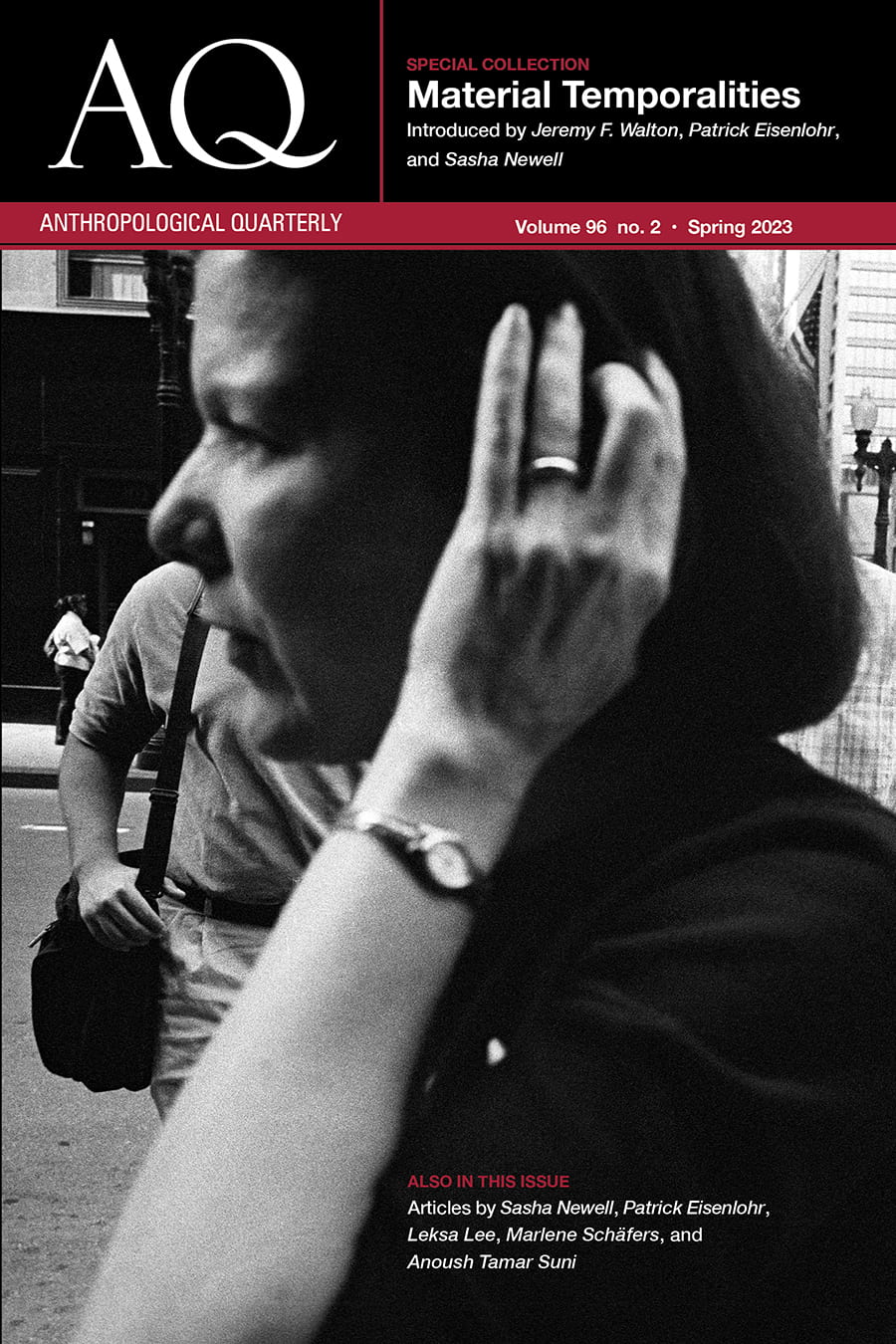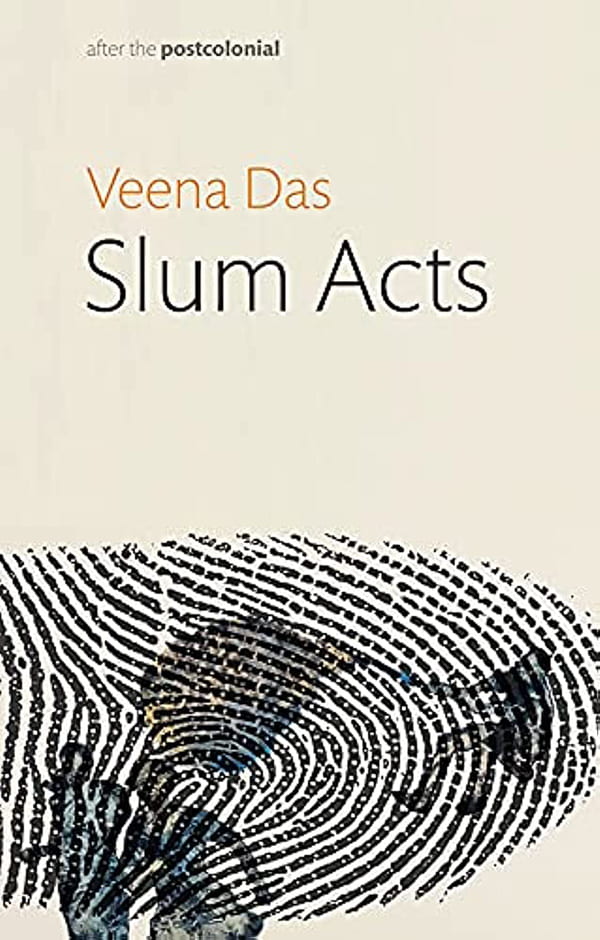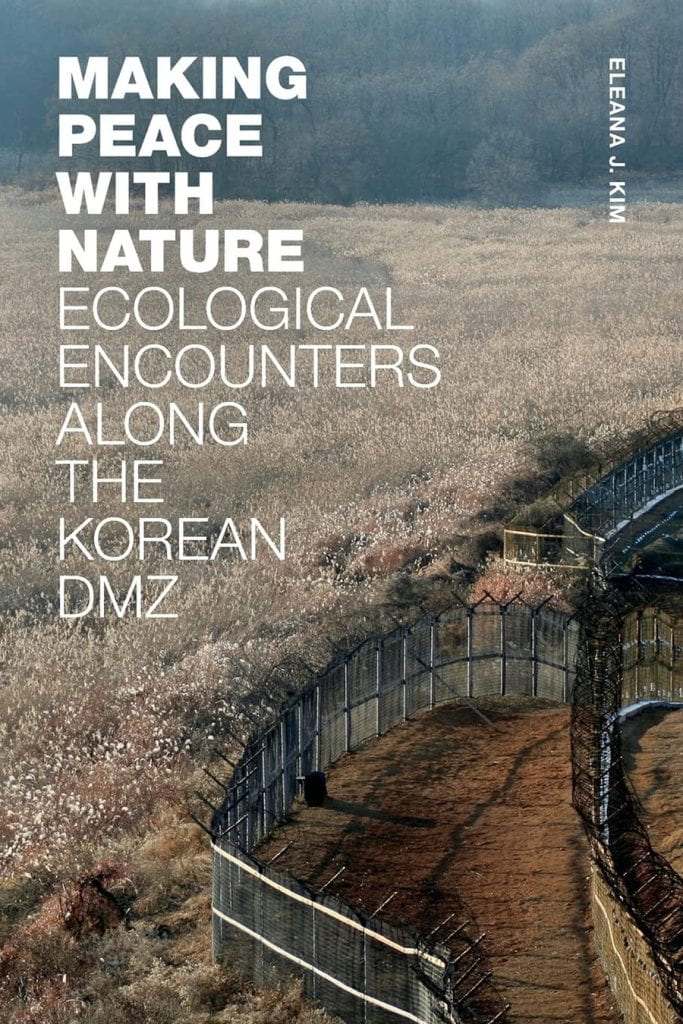
Street scene, NYC, 2003. © 2003 Edward Keating (Contact Press Images)
TABLE OF CONTENTS
Vol. 96, No. 2
SPECIAL COLLECTION
MATERIAL TEMPORALITIES
INTRODUCTION
Jeremy F. Walton, Patrick Eisenlohr, and Sasha Newell | Timely Matters
Sasha Newell | The Time of Clutter: Anti-Kairos and Storage Space in North American Domestic Life
Patrick Eisenlohr | Latent Cosmologies, Latent Media: The Material Temporality of Twelver Shi‘i Media Practices in Mumbai
Leksa Lee | Developmental Speculation: Materializing the Future in China’s Urban Planning Museums
Marlene Schäfers | Projecting a Body Politic: Photographs, Time, and Immortality in the Kurdish Movement
Anoush Tamar Suni | Historical Alchemy: Buried Gold, Buried Pasts
BOOK REVIEWS





Hafsa Arain | Omar Kasmani’s Queer Companions: Religion, Public Intimacy, and Saintly Affects in Pakistan
Navjit Kaur | Veena Das’s Slum Acts (After the Postcolonial)
Gebhard Keny | Eleana Kim’s Making Peace With Nature: Ecological Encounters Along the Korean DMZ
Briel Kobak | Britt E. Halvorson and Joshua O. Reno’s Imagining the Heartland: White Supremacy and the American Midwest
James Slotta | Susan Gal and Judith T. Irvine’s Signs of Difference: Language and Ideology in Social Life

©2014 David Burnett. Contact Press Images
Buy issue through PROJECT MUSE, JSTOR or our ONLINE STORE.
ABSTRACT
The Time of Clutter: Anti-Kairos and Storage Space in North American Domestic Life
Sasha Newell, Université Libre de Bruxelles (ULB)
Clutter fragments the temporality of the home and storage space offers a technology of containment with which to keep these portals to the past and future open, but not openly visible. Storage space is not a spatial but a temporal solution, secreting objects that do not belong to this time until such time as they might be more appropriate. Possessors of such objects speak of being transported to specific moments of their past, or in Benjaminian fashion, of historical objects that provide a sensorial window into worlds otherwise unlived. Other future-oriented things provide access to dormant or merely imagined selves projected into Borgesian forking futures, alternate paths that owners refuse to relinquish even when their possibility is lost. Clutter, by definition out of place, is thus also extra-temporal, and untold acreage is occupied in wait for a near future when “there will be more time” to sort the debris. Storage, thus, offers a haven for “anti-kairos”—things of an inappropriate time. Indeed, the accumulation of clutter is itself an image of time, a means of understanding Bergson’s durée as an unfolding expansion of heterogenous unity that envelops us. Finally, the paper considers the relationship between these spatiotemporal trajectories of objects and the expanded spacetime of households as a kind of social value in itself, but one that must be kept balanced with the more kula-like value of circulation. [Keywords: storage, clutter, temporalities, materiality, domestic, North America, Bergson, Benjamin, spacetime]
Latent Cosmologies, Latent Media: The Material Temporality of Twelver Shi‘i Media Practices in Mumbai
Patrick Eisenlohr, University of Göttingen
In this essay, I argue that the temporal figure of latency is central for an understanding of the material temporalities of media. Latency as a temporal figure is built into the material functioning of sound reproduction and audiovisual media. The discussion shows how latency underpins technical processes of storing and reproducing sounds and moving images in a broad sense, while analyzing mediatic latency in Twelver Shi‘i media practices in Mumbai. The focus on latency as a key temporality of media is also useful for thinking about Twelver Shi‘i ritual life and media practices because the temporal figure of latency features very prominently in Shi‘i eschatology and ritual life. Mediatic latency and the latency built into Shi‘i ritual life and cosmology interact in highly significant and productive ways, reinforcing a complex of piety and ritual commemoration that nowadays is thoroughly integrated with audiovisual media practices. The media practices studied mobilize different affordances of contemporary media, such as creating contemporaneity with the non-contemporaneous and the invocation of linear progress for different religious ends. [Keywords: time, temporality, media, Materiality, Twelver Shi‘ism in Mumbai, religion and media]
Developmental Speculation: Materializing the Future in China’s Urban Planning Museums
Leksa Lee, Denison University
Local governments in China are building thousands of urban planning exhibition centers across the country. These museums and their gigantic scale models depict cities years in the future, after local infrastructure and industrial development projects have been completed. Yet exhibition industry insiders say the futures they depict are unlikely to be realized, raising the question of why local governments would invest so much in producing them. I argue that the exhibition centers and their city models are a material form of financial speculation aimed at inspiring high-level officials to fund local officials’ municipal development projects. The emerging ethnography of speculation identifies it as an engagement of the future in the present that is meant to compel and inspire. Through ethnographic work on China’s museum industry, I show that China’s new urban planning exhibition centers are a tool of “developmental speculation:” a postsocialist, intra-governmental, political, and financial form of risk-taking that stakes claims on future economic development and that works through inspirational narrative. In the museum industry, local officials and museum production companies use material acts of modeling and design to link local initiatives to state policies, and to meld the present city with the future city in the scale models. The scale models embody past, present, and future together in one heterochronic material object. Thus, if speculation works through fantastical narratives, China’s new urban planning exhibition centers are narratives modeled in material, meant to inspire higher-level officials. They are speculation materialized. [Keywords: speculation, materiality, cities, the future, exhibition, design, China]
Projecting a Body Politic: Photographs, Time, and Immortality in the Kurdish Movement
Marlene Schäfers, Utrecht University, Netherlands
Many followers of the socialist Kurdish liberation movement surround themselves with photographs of fallen militants who they respect and celebrate as martyrs. These images hold considerable power: they are able to direct speech, shape bodily comportment, and command the everyday lives of their spectators. This paper asks where this potency stems from and what effects it has. Based on ethnographic fieldwork with Kurdish communities in Turkey and Europe, it argues that displays of martyrs’ photographs project a Kurdish body politic in the making, enrolling both those whom they depict and those who handle them into an alternative project of sovereignty that remains under acute assault. Key to this effect is how the photographs make the dead latent in the present. On the one hand, this makes the images immensely powerful media of political mobilization. Embodying the sacrifice of lifetime made by the fallen, the images become powerful vectors for feelings of indebtedness, commitment, and dedication that make distinct demands on the disposable time of those who contemplate them. On the other hand, photography’s capacity to make the absent present and thereby upset linear emplotments of time also makes it a potentially unsettling medium. As a result, photographs of martyrs become crucial sites where political belonging and commitment are fashioned, consolidated, and potentially rebelled against. [Keywords: photography, martyrdom, immortality, time, sacrifice, Kurdish movement]
Historical Alchemy: Buried Gold, Buried Pasts
Anoush Tamar Suni, Northwestern University
This article attends to the material legacies of past violence through a focus on the contemporary search for buried gold in the Kurdish-majority region of Van in southeastern Turkey—gold believed to have been left behind by Armenians fleeing the 1915 Genocide. Grounded in an exploration of local narratives and practices of treasure hunting, it demonstrates how the search for buried gold illuminates the multiple, contradictory, and ambiguous ways that the violent history of the Genocide continues to animate and enchant everyday life in the region. Through a focus on the semi-illicit digging for buried gold in a post-genocide geography, this article highlights how past and present cycles of violence are sedimented into the material landscape and how memory, temporality, and the reverberations of historic crimes coalesce in the enchanted objects hidden beneath its surface. By approaching treasure hunting as an embodied interaction with the past, it argues that the search and digging for mythical buried gold is a material recognition and unearthing of the taboo and officially denied history of the destruction of the Armenian community. Furthermore, it argues that treasure hunters translate an understanding of the violent past of the Genocide into buried gold in the present—what I term “historical alchemy.” The process of historical alchemy, which involves the transformation of a history of genocide into gold, demonstrates the fundamentally material quality of how the past is imbricated in the present and sedimented in the landscape. It is this material temporality—echoes of past genocide emerging from the earth as buried objects and remnants of a silenced history made physical in the present—that highlights the intrinsic links between 1915 and 2015, between the Armenian and Kurdish communities, and between ongoing cycles of violence, ruination, and dispossession. [Keywords: treasure hunting, materiality, temporality, enchantment, violence, genocide]

